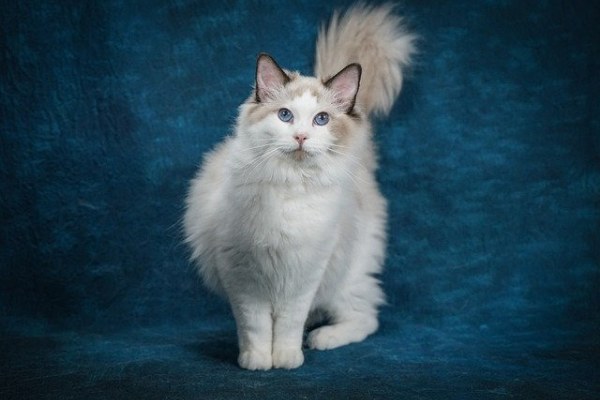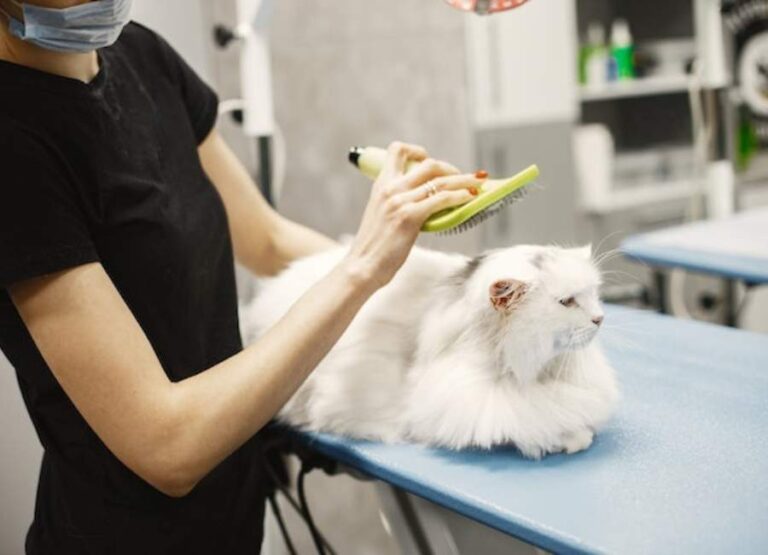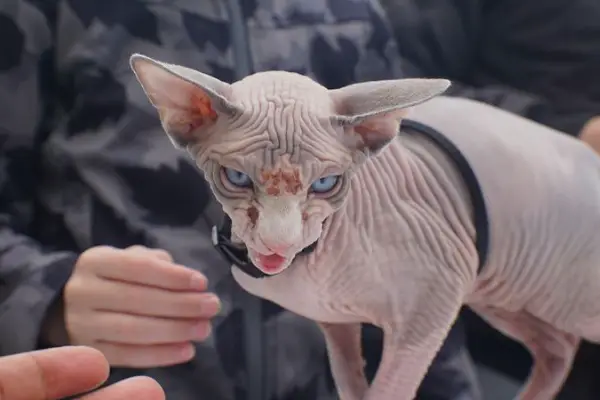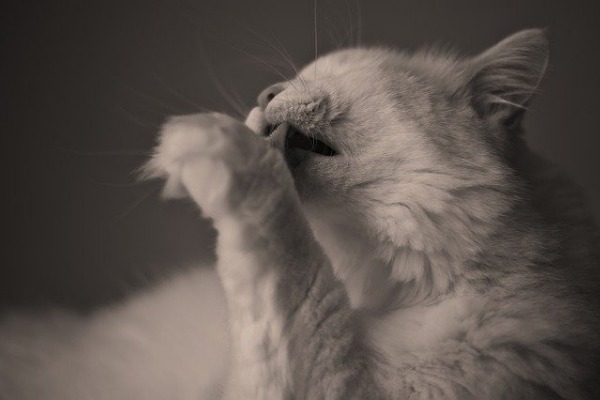37 Facts About Ragdoll Cats You Should Know

Are you a Ragdoll cat lover, and you are searching for facts about ragdoll cats? Then this post is for you, in this post we will discuss all you need to know about Ragdoll cats.
The Ragdoll cat is a breed of domestic cat that has a distinctive, docile temperament. It’s also known for its blue eyes and its tendency to go limp when picked up by the neck, hence the name.
The breed was created by Ann Baker in the 1960s by crossing various long-haired cats.
The cats are bred with colors in mind, which are divided into traditional, bi-color, blue, lilac, red, cream, and tortoiseshell.
These cats are wonderfully friendly and can make great companions for people looking for a new pet. But don’t just take my word for it!
Read on to learn more about these adorable felines. In this post, you will find both ragdoll cat pros and cons as well as behavior issues so read on!!!
Facts About Ragdoll Cats
Ragdoll cats are known for their calm, docile personalities. They come from a long line of Persian cats that were bred with Birman-type cats in the late 1960s.
Here are some more interesting facts about these cuddly creatures that will help you decide if they’re the perfect addition to your family:
Ragdoll cat kittens are born white
Every pure ragdoll kitten is born white, however as the kitten grows bigger, its color may change.
Between one and two weeks of age, their color and pattern appear. The breeder may then predict the color and pattern of their kittens.
Based on the color/pattern of the parents, the breeder may estimate what color/pattern combinations will be available in a litter of kittens.
Ragdoll cats trigger allergic reactions
There is a common misconception that persons with allergies would have no issues living with ragdolls, however, this is a massive falsehood.
Ragdolls have no undercoat, which makes cleaning up after them easier. They can, however, still cause allergic responses.
If you are allergic to fur and sneeze or feel ill when exposed to cat hair, you may find it difficult to live with any other cat, ragdoll or not.
If you have allergies, be sure you can manage a Ragdoll in your home because they shed a lot.
Or, if you’re not sure whether you’re allergic, find out before adopting a Ragdoll cat.
They are regarded as one of the least allergenic long-haired cats. But, once again, there are no assurances.
Ragdoll cats are full-grown at 4 years
Ragdoll cats are a breed that takes a long time to mature. This means they aren’t considered fully grown adults until they are four years old.
At the age of 3 to 4 years, ragdolls stop developing; at this time, all developmental processes in a ragdoll come to a standstill, and only then can you determine whether your ragdoll is fully grown or has stopped growing.
Before a ragdoll reaches this age, several things occur, the most obvious of which is the continual development of coat color intensity, consistent weight gain, and progressive growth in height and length.
Ragdoll cats are not mousers
Cats are thought to scare mice away, but this is not the case with ragdolls. Rodents will still infiltrate your home and destroy your belongings even if you have a ragdoll cat.
This is due to the fact that ragdoll cats were carefully selected to be human companions rather than hunters.
However, having a cat who will sit and watch rodents play political violet with your things is still extremely awful.
Ragdoll cats are not your average cat that will keep every single rodent away from your home except during training.
California produced the first Ragdoll cat
The Ragdolls were created in the 1960s by Anne Baker of Riverside, California.
She registered the term Ragdoll as a trademark and established her own registry, The International Ragdoll Cat Association (IRCA), which imposed strict criteria on anybody who wished to breed or sell cats under that name.
Ragdoll cats are affectionate
Are you looking for a cat breed that is both affectionate and friendly? Ragdolls have you covered.
Ragdoll cats develop close relationships with their owners and demonstrate their love for them and their families.
This is why most ragdoll cat owners would want to acquire more ragdoll cats after losing their first. In short, a ragdoll cat’s level of loyalty to its owners is unquantifiable and priceless.
Ragdoll Cats are indoor cats
Ragdoll cats are best kept as indoor cats since they are extremely trusting and lack the sharpest survival skills.
A ragdoll cannot survive a day outside due to its inability to maneuver.
They’re also clumsier than other cats, so if you live near a road where cars might hurt your cat, you’ll have to take extra steps to keep your cat from running.
Ragdolls are a great choice if you want a cat that will spend most of its time indoors with you. The fact that these loyal felines are kept indoors makes them very happy.
Ragdoll cats are lap cat breeds
Ragdolls like human connection and, unlike some other cats, enjoy being handled.
When early litters of the gentle, social cat were lifted up, they became limp and floppy like rag dolls, giving rise to the breed’s name.
Over 80% of ragdoll cat breeds won’t mind being picked up by their owners, compared to other domestic cats.
Ragdoll cat kittens are expensive cats
Ragdoll cats are extremely expensive, and obtaining a purebred ragdoll from a reputable breeder, as well as having them registered, will cost a significant amount of money.
A healthy purebred ragdoll cat from a reputable breeder should cost between $500 and $2500 USD. Prices, however, may vary from one breeder to the next.
The ragdoll’s age and size, as well as the exchange rate or currency value in your country, may all have an influence on the price.
In 1969 breeders began breeding more ragdolls
The earliest record of ragdolls being sold, according to the Ragdoll Historical Society, was in early 1969 when a couple purchased a breeding pair of ragdolls from Ann Baker.
Baker, on the other hand, had a strained relationship with Denny and Laura Dayton.
In 1971, Baker founded the International Ragdoll Cat Association (IRCA), reportedly in response to an increase in breeders.
She began franchising catteries that acquired breeding Ragdoll cats from her to retain an interest in the rising number of breeders.
When breeders refused to join a franchise, Baker began to lose control of the cat species she had developed.
Ragdoll cats are among the largest breed of cats
Ragdoll cats are one of the most popular cat breeds in the United States. This isn’t just a load of gibberish.
They may grow to be the size of a small dog, thanks to their medium to long coat and the fact that they can weigh up to 20 pounds.
A well-fed and healthy ragdoll cat has an average height of 9 – 11 inches (23 – 28 cm), a body length of 17 – 21 inches (43 – 53 cm), and a body weight of 8 – 20 lb (3.6 – 9.1 kg), with a lifetime of 12 – 17 years or more.
The majority of Ragdoll cats have blue eyes
The Ragdoll’s beautiful blue eyes will captivate any cat lover! This is a well-accepted fact.
Ragdoll eyes come in a range of shapes and colors, including blue.
It’s worth mentioning, though, that blue eyes are present in all purebreds.
The genes for point coloring are responsible for their distinct eye color.
While this breed is known for having blue eyes, they are not always present.
Ragdolls’ eyes darken as they get older, turning gold or greenish in hue.
Your Ragdoll is most likely a mix if her eyes are green or yellow in color.
Ragdolls are named from their floppy character
The name ragdoll derives from the fact that most of the cats of this breed would fall limp like a stuffed doll when touched, according to the International Cat Association (TICA).
In reality, some ragdolls are not lapped cats and dislike being picked up and handled, although they are quite patient and remain calm while carried.
When they’re in the mood to snuggle, they’ll surely do so.
Ragdoll cats require weekly brushing
Please let me know if there is another breed of cat that needs more grooming than ragdolls because ragdolls required more care the last time I checked.
Ragdolls’ worst trait is that they groom themselves when you don’t, resulting in hairballs.
Ragdolls will lick themselves even after grooming, so use the proper grooming tools and keep a vacuum cleaner on hand.
Unless you intend to vacuum the entire home, brush your ragdoll cat outside. Brushing your ragdoll cat twice a week is recommended.
Ragdoll cats need lots of attention
Ragdoll cats are so adorable and appealing that you could forget you have another appointment while they encircle you.
It’s tough to get up and go about your business when they fall on your lap because they want to snuggle.
If this is the case, you may be late for an appointment or complete tasks later than usual.
The ragdoll cat will needlessly follow you around the home.
And if you’re not paying attention, they’ll be overly polite.
Ragdoll cats are known as a gentle giant
Ragdoll cats are well-known for their calm demeanor.
Even if you inadvertently scare them, they seldom extend their claws.
It’s almost as though they’re willing to accept forgiveness.
These are the kitties you should avoid at all costs.
Ragdolls are sociable, caring cats who enjoy being handled and will look after their owners around the house.
Ragdoll cats are early morning fur shedders
People will tell you that ragdoll cats do not shed, but this is incorrect since they are one of the breeds that shed the most.
Ragdoll cats have long fur, which makes it easy to see how much they shed.
A thorough examination of ragdoll cats reveals that they shed first thing in the morning.
Find out more about the causes of shedding in ragdoll cats and how to control it here!!!
Ragdoll cats are very picky with what they eat
Ragdoll Cats can be quite picky about what they eat. This makes it tough for you to modify their food.
They never stop eating, and if you keep feeding them, you are inviting obesity, which has its own set of health problems.
Ragdoll cats are medium and lighter than bigger cats, therefore they require less food in general.
As medium eaters, they should consume approximately 250-300 calories each day.
Find out more about how much to feed a Ragdoll kitten!!!
Ragdoll cats can bite to get attention
If you are not paying attention to them or are attempting to close the door behind you, they may attack your legs.
They have the ability to bite you if they appreciate you and want your complete attention.
This continues until they stop growing at 42 to 45 months of age, and some Ragdolls can continue for a long time beyond that.
They can bite you even while they are playing with you, and if you try not to pay attention to them, they can act oddly at times.
Find out more about reasons why ragdoll cats bite and solutions.!!!
Ragdoll cats are prone to a few genetic diseases
As adorable as Ragdoll cats are, they are connected with a number of health issues, including the following:
- Urinary Tract Infections
- kidney disease
- Hypertrophic Cardiomyopathy (HCM)
- Mucopolysaccharidosis
- Gastrointestinal disorders
How To Identify A Sick Ragdoll Cat
Here are the common ways of Identifying a sick ragdoll cat;
- Loss of appetite
- Presence of worms in poop
- Lethargy and depression
- Difficulty breathing
- Dehydration
- Paralysis of the legs
- Coughing
- Fainting
Ragdoll cats can not be left alone for too long
Ragdoll cats sleep a lot throughout the day, so they may be able to spend more time alone.
Ragdoll cats, on the other hand, should not be left alone for more than 6 to 9 hours at a time, since they will become bored or hungry if left alone for an extended period of time.
Ragdoll kittens should be cared for carefully for at least 5 to 11 months before being left at home alone.
Ragdoll cats will follow you around tirelessly
Ragdoll cats will not leave you alone; they have no concept of privacy and will follow you everywhere, including the restroom.
They will not give you a breathing space like other cats and will follow you around the home all day.
You will always glance for your ragdoll cat before getting out of bed or walking down the stairs.
Some people see this as a bad thing about ragdoll.
This appears to be too much for some people while being enjoyable for others, so it all depends on what you expect from a cat.
Ragdoll cats have unique temperaments
Here are some unique ragdoll cat personalities you should know which are as follows;
- Docile
- Calm
- Sociable
- Friendly
- Loving
- Vocal
- Adaptable
- Affectionate
- Gentle
Ragdoll Cats are the most beautiful cat breed
Have you ever seen a more gorgeous cat breed than a ragdoll kitten under the age of one?
Ragdolls are without a doubt the most gorgeous cat breed.
Every ragdoll cat is born pure white, regardless of the ultimate color of the cat, and then they develop a varied color development as they mature.
Ragdoll cats get along with other cats
Yes, ragdoll cats get along well with other cats, and their gentle temperament, kindness, and loving nature make them excellent companions for cat-owning households.
Ragdolls are gentle creatures who get along with cats of all breeds and sizes.
The best thing you can do for your ragdoll is to get a second cat, ideally another ragdoll.
Ragdoll cats are usually distinctive when it comes to socializing with other cats.
They have a different energy level when they’re around other cats and get along swimmingly.
You’ll need to get a second cat if you don’t live with your ragdoll all of the time.
Ragdoll cats get along with kids
Ragdoll cats are excellent for keeping with children, but their size necessitates teaching your children how to care for them.
Children aged 8 and up who are able to handle and play with ragdoll cats get along better.
They could get more entangled with a more kind and caring family member.
Ragdoll cats get along with dogs
Because of their soft, charming disposition, Ragdoll cats get along well with dogs.
Ragdolls are recognized for their peaceful and laid-back attitude, which makes them great lap cats and friends.
They’re also recognized for tolerating other pets, making them a great addition to any household.
Ragdolls are without a doubt one of the most dog-friendly cat breeds. This is owing to their distinct personalities.
Because ragdolls are prone to separation anxiety due to their continual need to be with their family, having a ragdoll and a dog together is never a bad idea.
Ragdoll cats can’t go outside without supervision
Yes! Ragdoll cats are permitted to go outside with their owners’ permission and supervision.
Allowing your ragdoll cat outside alone is not a smart idea since they are still exposed to hazards such as cars, other animals, parasites, and illness.
If you must let your cats out, keep them on a leash or harness and take steps to protect them from these risks.
Contrary to common perception, cats do not require their owners’ supervision when they go outside.
There are a variety of reasons why you should never let your ragdoll cat outside unsupervised.
Ragdoll cats are very calm, gentle, and playful
Do you need a cat that is quiet and comfortable and does not strive to flee all the time?
Ragdolls, on the other hand, are well-versed in this area. All you have to do is satisfy his requirements.
They are terrible hunters who aren’t easily distracted by the presence of a mouse in their vicinity.
Ragdolls are known for their insatiable demand for endless hugs from their owners, as well as their love of the fetch game as a form of exercise.
They like playing with children and other pets, so if you have an active youngster who is capable of handling a ragdoll, you’re in luck. Ragdolls can entertain themselves for hours.
Ragdoll cats are obsessed in grooming and licking
Ragdoll cats are noted for their proclivity for grooming (this is scratching and licking their paws which leads to a health condition known as hairballs).
Furballs are formed when your Ragdoll injects its fur, which may cause your Ragdoll to vomit.
Ragdolls have long, easy-to-groom hair, so spend some time grooming (combing) yours or expect to spend a lot of money at the vet.
Because fur is not digested, it produces hairballs, which are one of the most common health problems associated with Ragdolls.
Ragdolls, especially adults, have a proclivity for licking and grooming.
In cats, shedding causes loose hair or fur, so groom your Ragdoll at least once or twice a week to prevent fur ingestion.
Read a complete grooming guide for ragdoll cats and its benefits!!!
Ragdoll cats enjoy waking up their owners too early
Most Ragdoll owners have experienced this as one of the most prevalent Ragdoll behavior issues.
Ragdolls are known for sleeping much of the day and being lively at night.
Ragdolls are frequently lively cats when their owners are present. They don’t like it when their owners sleep while they’re awake.
Even if their litter box is free and close to where they slept, most Ragdolls will wake you up between 4:30 and 5:00 a.m.
Your ragdoll will begin scratching your elbow and bouncing about you till you wake up comfortably in the morning.
I just believe they’re selfish because while you’re at work, your Ragdoll will be resting, and when it’s time for you to have your early morning snooze, they’ll just wake you up.
Always make sure to deplete your Ragdoll cat’s energy before going to bed to prevent this sort of behavior.
Playing a late fetch game with your Ragdoll cat will keep you from waking up too early.
Ragdoll cats scratch furniture when bored
If you don’t pay attention to a Ragdoll cat who is demanding your attention, or if you don’t trim their claws, they may scratch your furniture.
They may scratch your furniture in order to get rid of any dead nails or claws you haven’t removed.
If you’re short on time, a scratching board might help keep them away from your furniture because ragdoll cats are prone to separation anxiety.
Most ragdoll cats are vocal when in need
Most ragdolls have difficulties regulating this habit, which is one of the most prevalent ragdoll cat concerns.
Ragdoll cats are known as one of the most indoor-dependent cat breeds.
If you don’t listen to a ragdoll when they need anything, they’ll grow enraged, clawing objects or screaming.
Ragdolls always want to be in charge; for example, if you’re standing, they won’t stop until you sit down with them.
Ragdoll cats can be excessively noisy when they need something, even if it’s something they can get without you.
Ragdoll cats are very friendly
Ragdoll cats are, in fact, friendly. Ragdolls, unlike other cat breeds that may be aggressive or disagreeable at times, are calm cats who want human attention.
They are gentle, quiet, and one of the nicest types of cats that were developed to seek human contact.
Ragdoll cats are great for families with children because they are gentle, affectionate, and laid-back, and they are always seeking love and attention from their owners, which makes them sociable cats.
Ragdoll cats show their affection in a number of ways. They leap onto your lap, brush against you, and purr when they’re happy.
Ragdoll cats are very loyal
While Ragdolls are typically sociable to strangers, they have a special bond with their caregivers.
These cats would go to considerable efforts to find and track down their household’s favored members.
Ragdolls are known for chasing their owners around the house.
It’s rare to see a Ragdoll at the front door greeting visitors.
Ragdolls nearly seem to be able to express their appreciation to their owners!
Ragdoll cats have a great average lifespan
While the average age of a Ragdoll is debatable, it is generally believed that they live between 15 and 20 years.
Please bear in mind that this is for a cat who exclusively spends time indoors.
Having an indoor/outdoor cat or an outdoor-only cat exposes them to a variety of potentially fatal illnesses and dangers, which might help to reduce this statistic.
Ragdoll cats come in six colors and four patterns
The CFA recognizes bicolor, van, mitted, and color point ragdoll cat coat patterns in six colors: seal, blue, chocolate, lilac, red, and cream.
Within that, their color spots might be solid, lynx, tortoiseshell, or torbie which is a combination of tortoiseshell and lynx.
Their paws are generally white, and their snout has a white patch. Colorpoint ragdolls are Siamese cats with no white spots.
On the front of mittend ragdolls are white feet and boots. Bicolor ragdolls are mostly white, except when their colors show through.
The only colorful portions of a Van ragdoll’s body are its mask, ears, and tail.
To understand more about ragdoll color and ragdoll cat color progression click here!!!!
I hope you now have more information on facts about ragdoll cats after reading this article!!!






